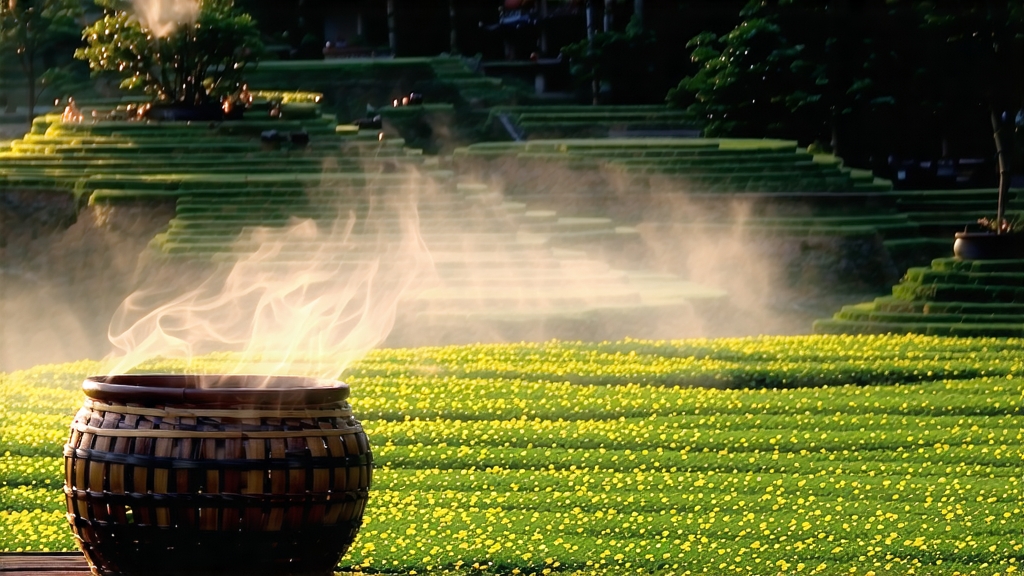
Meng Ding Huang Ya, literally “the yellow bud from Meng Ding,” is one of the most discreet nobles in the pantheon of Chinese tea. While green tea commands the market and dark pu-erh fills collectors’ vaults, this yellow tea from the mist-capped peaks of Ya’an, Sichuan, has survived dynasties, wars and modern neglect with its gentle, honeyed soul intact. To understand it is to step into a pocket of Chinese history where emperors once sent riders on fast horses just to taste the first spring picking, and where monks still greet dawn by lighting charcoal under iron woks shaped like half-moons.
History: from imperial tribute to near extinction
The earliest written record appears in the Tang dynasty (618-907) “Mengshan Chronicles,” stating that “the bud of yellow hue, picked before Qingming, pacifies the heart and cools the liver.” By the Song dynasty the tea was steamed, pressed into cakes and sent to Bianjing as tribute. When the Ming emperor Hongwu banned compressed tea in 1391 to relieve peasants of laborious cake production, Meng Ding makers turned to loose-leaf, accidentally discovering that a slow, humid “smother-yellow” step turned the leaves from grassy to mellow. The Qing court raised its status to “gong cha” (palace tea), allocating 360 jin (180 kg) annually to the Forbidden City. After 1949 the state re-organized gardens into communes; output peaked in 1988 at 15 tons, then plummeted as farmers switched to profitable green tea. Only a handful of elders kept the yellowing skill alive, and in 2008 the craft was listed as Sichuan Intangible Cultural Heritage, triggering a quiet renaissance.
Terroir: where clouds brush the tea
Meng Ding Mountain, a 1,450 m granite spine thrusting from the western rim of the Sichuan basin, traps monsoon moisture that condenses into year-round fog. The short-wave ultraviolet light filtered by vapor forces the tea bush to synthesize more theanine and less bitter catechins, giving the leaf its natural sweetness. Soils are acid yellow loam rich in selenium and zinc, drained by countless rivulets. The old-growth garden at Shangqing Peak, planted in the Southern Song with seed-selected shrubs, still yields the most coveted buds—tiny, downy and faintly yellow even before processing.
Varieties: three faces of the same bud
- Ming-qian Huang Ya: picked 5–20 March, one bud or one bud with an unopened leaf; 6,000 buds yield 500 g.
- Yu-qian Huang Ya: picked 21 March–5 April, one bud with one unfolded leaf; broader, more flowery.
- Gu-yu Huang Ya: picked 6–20 April, one bud with two leaves; stronger, suitable for aging six months to develop dried-apricot notes.
Purists insist only Ming-qian deserves the ancient name; locals drink Yu-qian daily, while Gu-yu is pressed into 100 g mini bricks for Chengdu teahouse steeping.
Craft: the secret art of “men-huang”
Yellow tea’s identity rests on a unique smothering step that oxidizes leaf pigments gently, nudging chlorophyll toward golden hues without the microbial fermentation of dark tea. After picking, buds are spread 2 cm thick on bamboo trays for 6 h withering, losing 8 % moisture. They are then wok-fired at 160 °C for 3 min to kill green enzymes; the hand motion, “tui-la-mo” (push-brush-rub), curls the tip into a tiny hook. While still warm the leaves are piled in a hemp sack and placed in a bamboo steam box for 40 h at 28 °C and 75 % humidity. Every 8 h the sack is opened to release trapped heat, a ritual called “fan-qiao” (turning the bridge). When the leaf edges turn primrose and the aroma shifts from fresh pea to toasted pumpkin seed, the tea is flash-dried over charcoal embers covered with plant ash to keep the temperature below 60 °C. The entire cycle takes five days, three times longer than green tea, explaining its scarcity.
Chemistry in transition
During smothering, epigallocatechin gallate (EGCG) decreases 18 %, reducing astringency. Amino acids rise 12